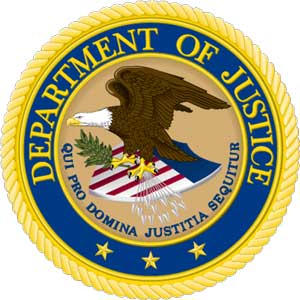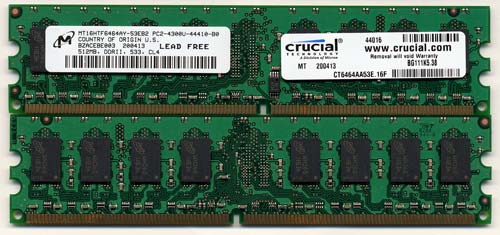In Memory Of The Law: The Memory Industry's Legal Problems
by Ryan Smith on October 25, 2007 3:00 AM EST- Posted in
- Memory
DRAM Price Fixing
In 2002, the major American computer OEMs banded together to complain to the United States Justice Department about potential anti-competitive actions in the memory market. From 1999 up to that point, the OEMs had been paying fairly high prices for their RAM for a sustained period of time, which was unusual given the volatile nature of the market. Given in particular the economic slowdowns in that period of time, the demand for RAM surely should have been well below the supply, and prices should have been hitting rock-bottom as a result. While the market was fluctuating somewhat, prices had not come down like they should have.

Starting with the complaints from the OEMs, it only took the Justice Department a year to start finding memory manufacturers guilty of engaging in price fixing as the OEMs believed. All told, the list of companies found guilty was practically a who's who list in the memory world, where no less than nine companies eventually pled guilty and/or settled. The companies were:
- Infineon
- Samsung
- Hynix
- Elpida
- NEC
- Winbond
- Micron
- Mosel.
- Nanya
In the 3-year period of anti-competitive behavior, the memory cartel is estimated to have overcharged American OEMs by at least a billion dollars, which in turn was eventually passed on to consumers. The direct consumer cost - that is consumers who were directly overcharged as opposed to being overcharged through their OEMs - is unknown, but given the shape of the market this would only be a fraction of the cost through the OEMs.
As for why this happened, there are two reasons given. The first is fairly typical: a desire to make more money. By fixing prices the cartel pulled in an additional billion dollars in the American market alone and avoided some of the drag from the economic slowdown of the period. A second reason that has been proposed has been that the price-fixing was done to force Rambus' RDRAM out of the market at a time when they were beginning their patent suits. RDRAM was subject to price fixing like all other forms of DRAM, and ended up always being priced comparatively higher than other forms of DRAM. This theory has never been confirmed (simply put, the Justice Department's job doesn't include finding out why the cartel did what it did), but it has always seemed extremely likely given the timing and the fact that RDRAM did indeed die in part due to high prices.
The real meat of the issue is not the cartel engaging in price-fixing; it's the punishments for doing so. The total of all the fines and settlements is well over a billion dollars, and with the addition of other associated costs the penalties are believed to be well in excess of the ill-gotten profits from the whole operation. Samsung, believed to be the ringleader of the cartel, holds in particular the dubious distinction of having paid the second largest antitrust fine ever to the Justice Department, at $300 million (and this doesn't include any further settlement costs). Hynix took the number three spot at $185 million, and Infineon became number four at $160 million.
Along with monetary fines, executives from several of the guilty cartel members were also directly found guilty and forced to pay their own fines and serve jail time. Individual fines ranged between $100,000 and $250,000, with jail sentences between 4 and 8 months.
Finally, on top of any official fines for their actions, there are the class action suits brought against the cartel to recover some of the money that the cartel overcharged. The members of the cartel have settled the class action suits to a total of $326 million, to settle any wrongdoing they've done towards anyone who purchased memory directly from the cartel. Now since this is only for direct purchases, the majority of the parties are the OEMs and mid-level companies that assemble and sell DIMMs; however, an interesting side-effect of this settlement is that end-users are also part of the eligible party when they purchased memory directly. Micron directly owns and operates the Crucial brand, so end-users who purchased memory from them in the time period are in a unique position of being one of the few (if not only) groups of users that will see a dime out of this settlement.

All told, the numbers from the operations of the memory cartel are staggering. Nine core companies with a number of subsidiaries of their own managed to organize themselves long enough to overcharge buyers by a billion dollars over a three year period. This is obviously illegal but at the same time it's an admittedly impressive act of collusion. In return they have been fined and sued for well over a billion dollars, easily erasing any gains and filling the better part of the United States Justice Department's top 10 fines list.
And yet the end isn't quite here. They say the wheels of justice turn slowly; one only needs to look at the time frame of this case to see why. What started as collusion in 1999 became an investigation in 2002, and claims for the class action suit will continue to roll in until the very end of 2007. By the time the claims are paid and the book is finally closed on this case, it will be 2008, some nine years after the initial crime started and six years after the investigation started. Retribution has been a long time coming. Sadly, while OEMs were indeed overcharged during this period, the reality is that it's the end customers that were really forced to foot the bill. Score points for the OEMs, the DOJ, and the lawyers; just pay no heed to the average Joe or the businesses that were overcharged for PCs or RAM during this period.










27 Comments
View All Comments
Bullettrap - Sunday, October 28, 2007 - link
So, how is the price of DDR3 coming along. It's seems a we bit high does'nt it. Should I be Suspicious. Lets hope this milking stops soon!Nighteye2 - Saturday, October 27, 2007 - link
The fines may have been given in the name of justice, but along with all the extra costs, the companies will now have to make up for the loss - by further raising of memory prices. Thus, consumers pay too much twice - and the justice department reaps all the profits.Locutus465 - Friday, October 26, 2007 - link
While what was done does seriously suck, I'm actually very glad R-DRAM is gone... In this case I think Memory OEM's saw Rambus trying to muscle them into a propriatary technology they would have to pay royalties for via the U.S. court system and decided to fight back. In the end, I'm glad this was done.Zoomer - Saturday, October 27, 2007 - link
Yup. A very positive side effect indeed.magreen - Thursday, October 25, 2007 - link
Ok, I have a slick idea. The OEMs and memory manufacturers get together. The memory manufacturers price-fix to overcharge. By a billion $$. The OEMs pass that cost onto the consumers who foot the $1 billion bill. The OEMs cry foul to the DOJ who fines the memory manufacturers $d00 million and force them to pay $1 billion to the OEMs. But together, the OEMs and memory manufacturers are still up $500 million. They split the pot and call it a day.NanoTec - Thursday, October 25, 2007 - link
I was expecting a “review”, every other memory article states the known facts about the product then goes on to try to test those claims with benchmarks providing more information.Were these manufacturers stealing? Were they breaking laws?
They were not forcing the consumer to buy memory or even charging one customer an exorbitant premium over another for the same product. They’re guilty of selling at the same price as their competitors.
http://query.nytimes.com/gst/fullpage.html?res=950...">1998: memory makers are accused of selling too cheaply “dumping”
http://query.nytimes.com/gst/fullpage.html?res=9B0...">2003: government decides you should pay 44% more
These are just two convenient examples, there is much more to this issue.
If one seeks an authoritative interpretation of the Sherman Antitrust act they need only see this paper by Alan Greenspan
http://www.polyconomics.com/searchbase/06-12-98.ht...">HERE
Ryan Smith - Thursday, October 25, 2007 - link
They were found and pled guilty to operating a cartel to artificially fix memory prices, which is a very anticompetitive action. This is a crime in the United States, and most other capitalistic nations for that matter, regardless of if customers are being "forced" to buy the product or not.Ryan Smith - Thursday, October 25, 2007 - link
http://www.dailytech.com/article.aspx?newsid=9410">SanDisk Sues 25 Flash Drive ManufacturersSunrise089 - Thursday, October 25, 2007 - link
Supposedly price fixing forced the OEMs to pay more, which they passed on to consumers. But then "end-users having purchased memory from [Crucial] are in a unique position of being one of the few (if not the only) groups of end-users that will see a dime out of this settlement." - So which is it? Do companies pass their costs and profits to consumers or not? There is no logical reason to assume a company that raises prices on its products to make up for increased costs won't also lower prices when it receives a windfall. Even if you believe all companies are inherently out to screw the customer, they still need to move product, and lowering prices while keeping profit levels the same (due to revenue from the suit) would be too good of an opportunity to pass up.RBBrittain - Saturday, October 27, 2007 - link
U.S. Federal antitrust law only permits "direct purchasers" to recover in price-fixing situations. In this case, this means most of the money goes to the OEMs that purchased DRAM chips from cartel members.OEMs aren't legally required to return that money to the end users, though in a business sense it improves their profitability and thus allows them more leeway in cutting future prices to compete. In the mechanics of business, a price increase (like what the cartel did) is almost certain to reach the consumer "bottom line" (i.e., end-user prices) very quickly; but price decreases (like ending the cartel and the legal settlements) take much longer to "trickle down". You see it in gas prices all the time, though stronger day-to-day competition tends to make the "trickle down" happen faster in that market.
Crucial is different because it's a direct-sales division of Micron, a member of the cartel. Unlike most end users, Crucial customers are "direct purchasers" from the cartel, so they're basically the only end users entitled to a recovery.
In a few cases, end-user recoveries can be forced if the right people act, especially state attorneys general. (Yes, that IS correct grammar; in that case "general" is an adjective, so the noun "attorney" gets the "s".) Though a Federal court decision (known as the "Illinois Brick obstacle") limits state AG recoveries under Federal law to direct purchasers, a growing number of states have their own laws overruling that and allowing their AGs to recover on behalf of indirect purchasers as well.
In a case involving the record industry (which used "minimum advertised price" policies to indirectly overcharge consumers for CDs in the late 1990s), enough AGs were able to sue that they forced a nationwide settlement which waived the "Illinois Brick obstacle" and reimbursed consumers in all 50 states. (There was also a related class action settlement with Columbia House and BMG record clubs--before BMG bought Columbia House--which was the legal equivalent of the Crucial settlement.)
Finally, don't assume DOJ made money off the DRAM case (as one commenter did); those fines went to the U.S. Treasury and merely reduced the Federal deficit. DOJ has to get its money from Congress just like any other Federal agency.